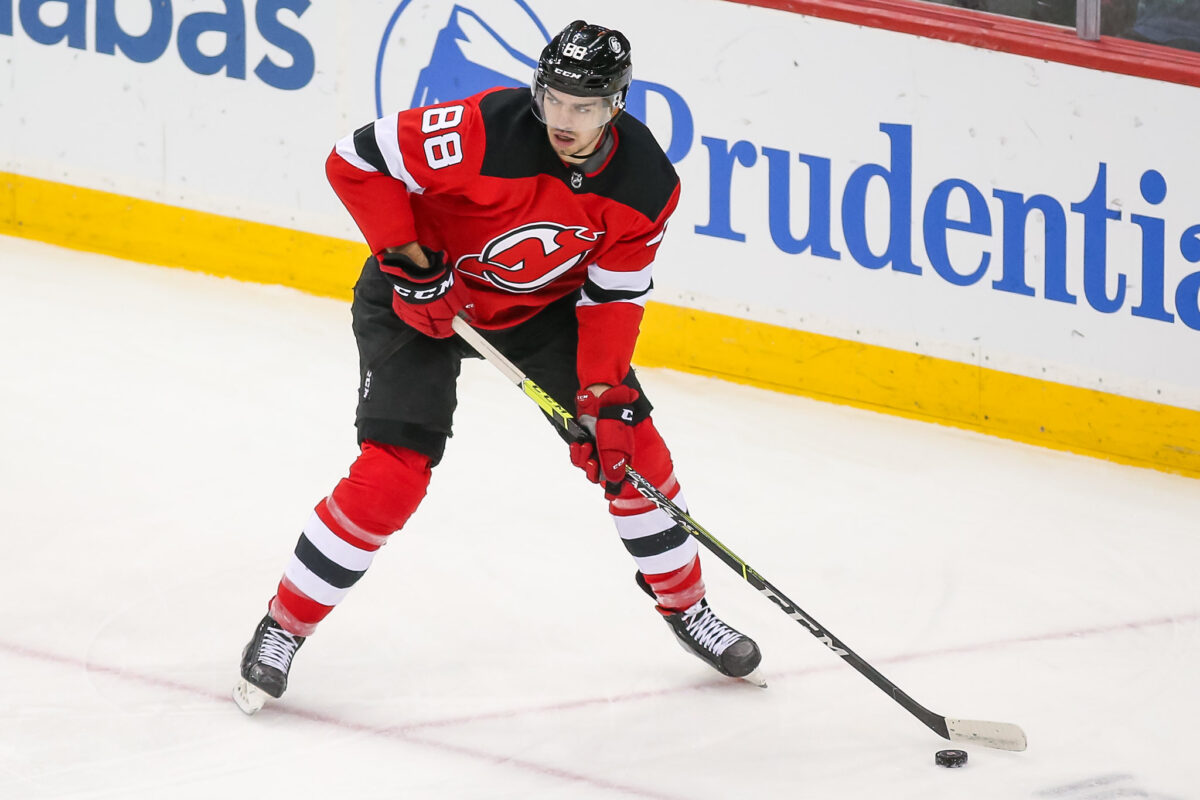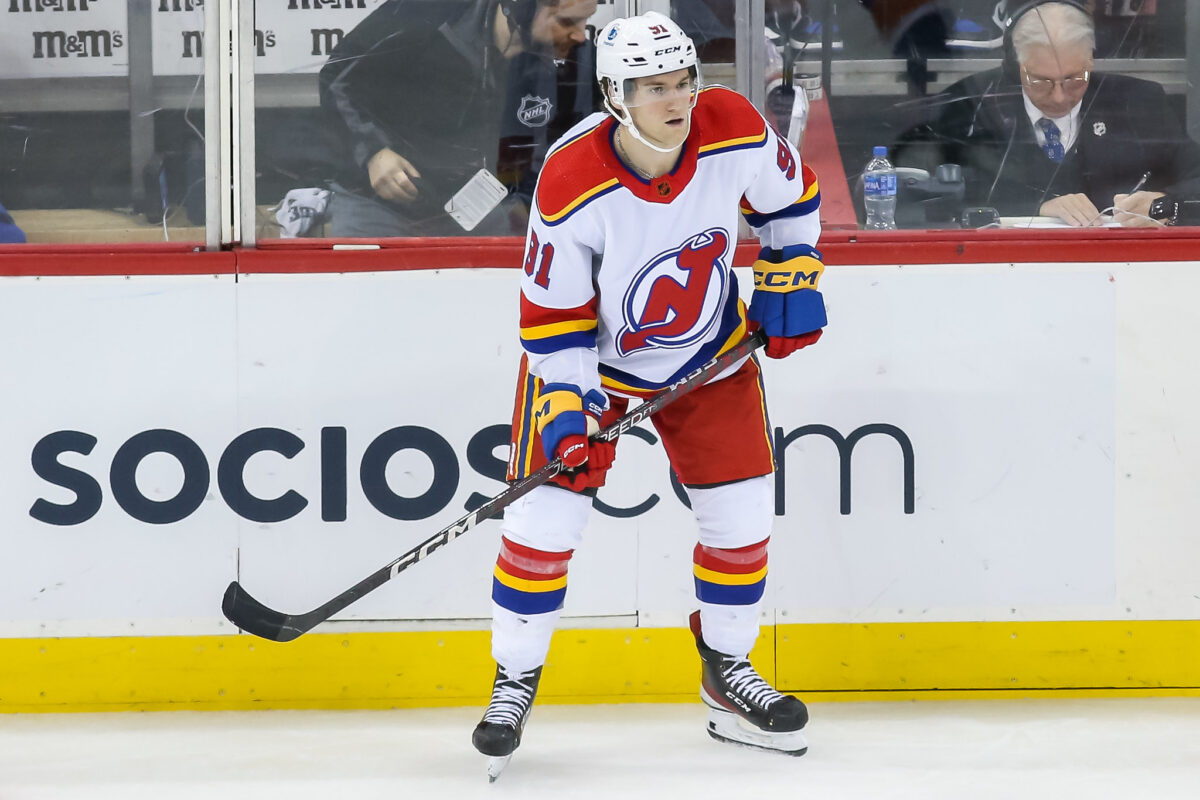Anytime a team makes a trade, there’s always an initial reaction from its fan base. “Did we win the trade?” “Was this the ideal return for said player?” The list goes on. When the New Jersey Devils traded Taylor Hall to the Arizona Coyotes three years ago to the date, most Devils fans seemed to think, “meh.”
That reaction wouldn’t have been unwarranted at the time. The Devils received prospects Nick Merkley, Kevin Bahl, and Nate Schnarr, a first-round pick in the 2020 draft and a conditional third-round pick in the 2021 draft. For a player of Hall’s caliber, who was just over a year removed from winning the Hart Trophy, the return appeared underwhelming, even though he was in the final year of his contract.
But as is the case with a trade that’s futures-based, such as Hall’s, coming out immediate winners isn’t always the case. Three years later, the Devils have turned the Hall trade into a massive win with three players who are regular NHL contributors, some significantly.
Bahl Beginning to Emerge as NHLer
At the time of the trade, Bahl was the deal’s centerpiece. He was one of the Coyotes’ top prospects, having been a second-round pick (55th overall) at the 2018 NHL Draft. At 6-foot-6, 230 pounds, he had a unique skill set of high-end skating but the potential to add a physical element on the back end.
Bahl played his junior hockey with the Ottawa 67’s in the Ontario Hockey League (OHL) with a few other Devils prospects, most notably Graeme Clarke and Nikita Okhotiuk. Bahl’s production with the 67’s wasn’t anything to write home about and was more a signal of the type of defenseman he could be in the NHL. In 180 games with 67’s, he totaled 83 points, indicating more of a defensive defenseman.

Bahl turned pro in 2020 and made his debut with the Devils toward the end of the COVID-shortened 2020-21 season. It was clear during his seven-game NHL stint that he still had a ways to go in his development, but he showed signs of improvement a year later when he played 17 games with the Devils. While his five-on-five metrics weren’t great, they were still significantly better than the previous season.
Three years after acquiring him, Bahl has yet to break into the Devils’ lineup as a regular. However, it appears he’s getting there. Even though he’s only appeared in five of the team’s 30 games this season, he’s played exceedingly well. His 74.76 expected goals percentage (xG%) leads all Devils skaters, though his sample size is minuscule.
Still, it’s only a matter of time before regular minutes come for him. Considering Schnarr and Merkley did not pan out (they’re no longer with the organization), Bahl becoming an NHL contributor would’ve made the trade a success. With that said, he’s just the tip of the iceberg when it comes to this trade.
Devils Turn First-Round Pick Into Mercer
Former general manager Ray Shero was the one who acquired the assets in the Hall trade. But with the team bottoming out in the standings at the time, Devils ownership decided to move on from Shero a mere month later. In time, Tom Fitzgerald would become the permanent GM after having the interim tag removed in July 2020. It would be his work that turned the Hall trade into what it is today.
Related: Former Devil David Clarkson: Where is He Now?
It started at the 2020 draft in October of that year when the Devils had three first-round picks, with one coming from the Coyotes as part of this trade. The Devils would use that selection on Dawson Mercer, a forward who played in the Quebec Major Junior Hockey League (QMJHL), with the 18th overall pick. Mercer was widely considered a top-15 prospect, so the Devils got good value with that draft choice.
To this point, it appears they made a smart decision. Mercer had a more than a solid rookie year in 2021-22, finishing with 17 goals and 42 points while playing in all 82 games. The Devils didn’t have much success as a team, but he showed he could be a valuable part of a roster Fitzgerald was building around Jack Hughes, Nico Hischier and Jesper Bratt.

Part of that was because Mercer played well at multiple positions. He started the season at center and found plenty of success with Bratt and Andreas Johnsson as his linemates. But as the year went on, head coach Lindy Ruff used him as a right wing alongside Hughes and Yegor Sharangovich. That trio showed potential, as they had solid five-on-five metrics and were one of the better lines Ruff used that season.
Though the trio of Sharangovich, Hughes and Mercer hasn’t gotten much run this season, the latter two have been on a line together quite a bit. In just over 182 minutes, the Devils have a 60.06 xG% and have out-chanced teams 109-71 with Hughes and Mercer on the ice. They also have a high-danger chance advantage of 44-22 (66.67 percent).
Whatever it is, Hughes and Mercer seem to have great chemistry together. Considering they’re both 21 years old, there’s the potential for them to be linemates for a long, long time. We could end the article here and say job well done to Shero and Fitzgerald. The Devils have a top-six contributor in Mercer and someone who’ll become an NHL regular in due time in Bahl. But neither of those players may be the best to come out of this transaction.
Devils Took Low-Risk, High-Reward Chance on Siegenthaler
With the Seattle Kraken Expansion Draft looming, the Washington Capitals had to make a move to clear out a logjam along their blue line ahead of the 2021 trade deadline. That ended being dealing Jonas Siegenthaler to the Devils for the conditional third-round pick they acquired from the Coyotes for Hall.
Siegenthaler was mostly a healthy scratch for the Capitals in 2020-21, so it didn’t seem they valued him enough to use a protection slot on him at the expansion draft. The Devils pounced on the opportunity to take a chance on a defenseman who hadn’t played much but had some encouraging underlying numbers:
As the tweet from JFresh says, Siegenthaler wasn’t getting much ice time, but his defensive impacts were pretty outrageous in his limited minutes. For an organization that went into rebuild mode 2.0 after trading Hall, it was the type of low-risk, high-reward acquisition a team in their position needed to make.
As it turns out, the reward for acquiring Siegenthaler has been much more than the Devils could’ve asked for. He had a breakout year defensively in 2021-22, with his even-strength defense being worth an expected goals above replacement (xGAR) of 10.3, ranked first among all defensemen league-wide. As a result, the Devils and Siegenthaler agreed to a five-year contract extension this past summer at an average annual value of $3.4 million; it kicks in for the 2023-24 campaign.
The Devils were certainly right to sign Siegenthaler to an extension a year ahead of him becoming a restricted free agent. Though he hasn’t turned into a scoring dynamo, he’s added more offensive weapons to his arsenal this season and has become more of a two-way defender rather than a pure shutdown defensive defenseman. With 11 points in 29 games, that’d put him on pace for 31 this season, which would easily be a career-high.
Related: Taylor Hall for Adam Larsson Trade Revisited
Siegenthaler has transformed from a depth defender during his time with the Capitals to a top-pair blueliner to comprise one of the best defensive pairs in the league alongside Dougie Hamilton. Perhaps the Devils saw that type of potential in Siegenthaler when they acquired him. But even if they did, it requires a bit of luck when taking a flyer on a player like him and having him develop into what he is.
The Hall trade would’ve been a win with Mercer and Bahl turning into NHLers, but Siegenthaler becoming a top-pair, two-way blueliner made it a game-changer for re-shaping the team’s roster. It didn’t look like the Devils received much value at the time they dealt Hall. But with some prudent work (and some luck) in the following years, it’s turned into a massive win.
* * *
Advanced stats from Natural Stat Trick, Evolving-Hockey
